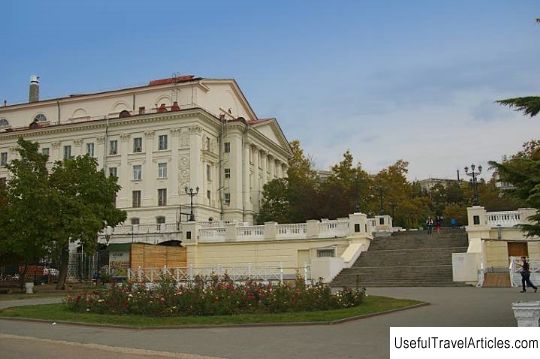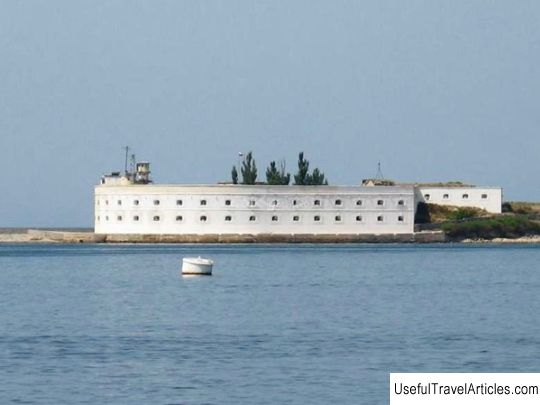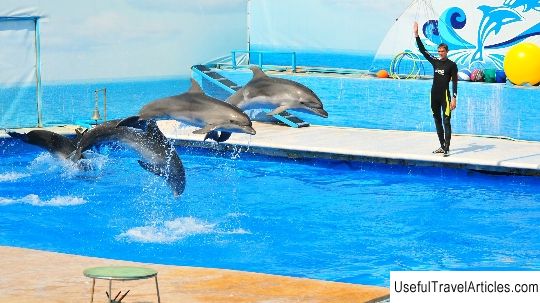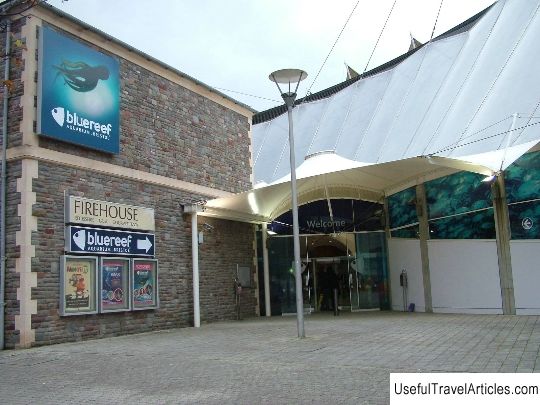Aquarium-Museum description and photos - Crimea: Sevastopol
Rating: 8,0/10 (1244 votes) 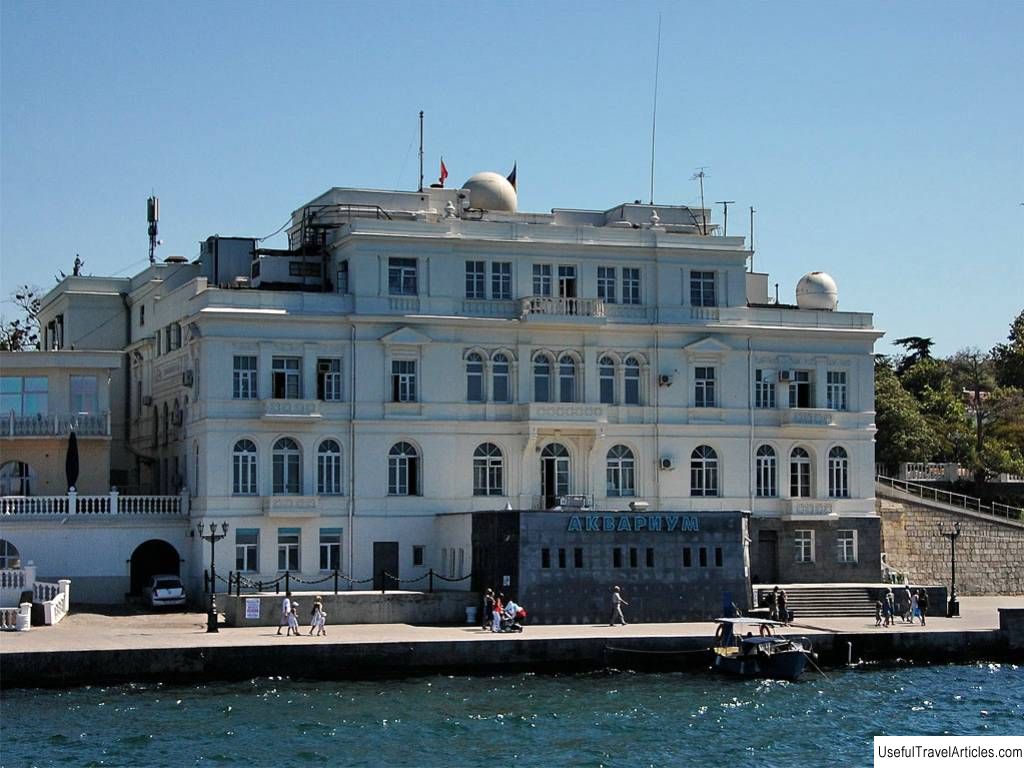
Aquarium-museum description and photos - Crimea: Sevastopol. Detailed information about the attraction. Description, photos and a map showing the nearest significant objects. Photo and descriptionMuseum-aquarium in Sevastopol at the South Seas Institute , one of the oldest museums of its kind in Europe. Collections of tropical fish, Black Sea fauna and exotic amphibians will not leave anyone indifferent. History of the MuseumSevastopol Biological Station was created in 1871. This happened on the initiative Novorossiysk Society of Naturalists. This is one of the oldest marine biological stations in Europe, and for the Russian Empire it was the very first. The first head was the zoologist Vasily Nikolaevich Ulyanin , who was engaged in research of the Black Sea fauna all his life. The second head in 1880 was Sofia Mikhailovna Pereyaslavtseva . After Countess Dashkova in the 18th century, she was the first woman to lead a scientific institution in Russia. PhD and zoologist, she was one of the most prominent Russian researchers of the biology of the Black Sea. Sofya Mikhailovna discovered more than forty species of invertebrates. Since 1889, Alexander Onufrievich Kovalevsky becomes the head. It was he who came up with the idea of creating a museum-aquarium. He traveled a lot abroad and studied the experience of other similar biological stations and aquariums. During his reign, a rich scientific library was created, and a new building for a biological station was built under him. Prior to this, the station did not have suitable premises and moved several times. The place was chosen on the very shore on the site of the former Nikolaev battery . The new building was immediately built with the expectation that that it will contain a marine aquarium. In 1897 the museum was opened. Now in front of the museum you can see a monument to its founder. It was originally here one room with a pool and seven aquariums. The exposition included only the Black Sea fauna. The museum had educational functions: three days a week it was open free of charge to all visitors. In addition to the aquariums themselves, there were stands with various samples, tables and other non-living exhibits. In 1912, the building of the biological station was renovated. One more wing was added to it specifically to house scientific collections. After the revolution, the museum continues to work: in 1926, for example, more than twenty thousand visitors were registered during the year. In the 1930s, another reconstruction followed: another wing was added and the fourth floor was added. During the Great Patriotic War, the building itself miraculously survived, but the museum collections have not survived. Most of the inhabitants of the aquarium died - there was no one to look after them. Until 1951, the building and aquariums were being restored. For twelve aquariums , a dedicated room has been allocated on the lower floors. More than 30 species of fish and animals were presented there. The biological station carried out research work and organized expeditions to replenish collections and study the Black Sea fauna. In the mid-60s, a reorganization took place: the Sevastopol Biological Station became Institute of Biology of the South Seas . Now one hall was occupied by aquariums and a swimming pool, and two halls were occupied by a museum exposition. The last reconstruction of aquarium equipment was carried out in 1994 , and at the beginning of the XXI century new halls were opened with sharks and moray eels. AquariumNow the museum occupies five halls . The first hall is the Museum of Hydrobionts of the Southern Seas. This is the most popular and beautiful exhibition dedicated to the inhabitants of tropical sea waters. Inhabitants of tropical warm seas are the oldest creatures on earth. The biological systems of the southern oceans are the most complex and richest of all. Besides the most beautiful tropical fish here are the oldest inhabitants of the planet. These are corals, sponges, anemones , various types of molluscs and arthropods. Sponges are one of the very first multicellular organisms, they appeared on the planet at the beginning of the Cambrian and have not changed at all since then. A little later, arthropods appeared - their evolution began 555 million years ago. The modern arthropods that can be seen in the aquarium include numerous species of marine shrimp, hermit crabs, and crabs. In general, invertebrates make up the majority of modern living organisms: there are many more species of various invertebrates than fish! But of course, there are fish in this collection too. There are more than twenty thousand species of them on the planet. The brightest and most colorful of them live in shallow waters near coral reefs. But in addition to the beautiful "aquarium" fish in the museum you can see predatory moray eels and piranhas, dangerous sea urchins, lionfish and other marine life, which are best seen in the museum, and not meet with them in person. p> The second hall is entirely dedicated to the Black Sea . This is the central room of the aquarium, here, in addition to the exposition, there are diagrams of all the other rooms and a small souvenir shop. This hall is a direct heir to the very first museum, which was dedicated primarily to local residents. Here is the largest aquarium collection of the Black Sea fauna in the world. Aquariums are decorated in the form of various fragments of the seabed: you can see sunken ships of different times, and antique underwater ruins. The Black Sea is inhabited by several hundred species of different algae and about two and a half thousand species of animals : more than 160 species of fish, more than 500 different crustaceans, etc. The exhibition also includes commercial fish : herring, mullet, mackerel, horse mackerel, salmon - and dangerous and even poisonous. For example, stingrays sea cat and sea fox, several species of scorpionfish and sea dragon. And most of all, the attention of visitors is attracted by the large pool with live sturgeons . Russian sturgeon can reach two meters in length and live up to forty-five years. Unfortunately, sturgeon is almost never found in the wild now, but it is actively raised on special farms. Third Hall . This room is the oldest hall of the museum, The first seven aquariums of the early 20th century were once located here. Now there are representatives of freshwater fauna . There are several aquariums in the hall, which reproduce the living conditions for the inhabitants of different rivers and lakes. The most interesting life, of course, is in the southern tropical waters. The Amazon basin, the Cambodian rivers - all this can be seen here. The fourth hall is the Exotarium. It is dedicated to reptiles. Several species of turtles live there. For example, the unique soft-bodied freshwater turtles is one of the oldest species of turtles in general. They have a shell, but it is not covered with a stratum corneum, but with skin. These are the pork turtle from Australia and the Nile Trionix from Africa. There are also sea turtles on display. For example, the green turtle - it is found in the Atlantic Ocean and can reach one and a half meters in length and four hundred kilograms of weight. Also, of course, you can see here the most common freshwater turtles now - red-eared turtles. They were once brought to Europe from America, and now their spread has become a real ecological disaster. They do not have natural enemies in Europe and actively reproduce. But, of course, the star of the Exotarium is "Gena the Crocodile". In fact, he is not a "crocodile", but a "crocodile caiman". His predecessor (who lived a long and happy life here) remained in the form of a stuffed animal in one of the halls. He was personally acquainted with Raul Castro. The Cuban delegation, which visited Sevastopol in 1979, was terribly happy about "their own". Caimans are relatively small beasts. They can be as little as two meters in length. Larger crocodiles consider them to be prey. They themselves feed mainly on fish, shellfish and crabs - and are very useful: for example, they gladly eat predatory piranhas from water bodies. The fifth hall is deadly . Representatives of the marine fauna are gathered here, a meeting with whom not in a museum environment can end in failure. The hall was created in 2013 for the Day of the Navy. A huge forty-ton aquarium is occupied by sharks . These are black fin reef sharks, one of the most dangerous predators of the marine world. A slightly smaller aquarium is intended for predatory moray eels . Also on display is the famous Japanese puffer fish , poisonous if not properly prepared. There is electric eel here. In fact, he has nothing to do with acne, just a little similar in appearance. This fish can reach three meters in length and create an electrical discharge of up to one and a half thousand volts. Organs that generate electricity occupy three quarters of the length of his body. Another unique feature of this fish is the need to breathe regular air. Three or four times an hour, the eel rises to "breathe". But even without water, he can do for several hours. This fish lives in bolts and oxbows along the Amazon. She uses electricity not only for hunting, but also for orientation in space. In addition to aquariums and living abodes, the museum includes other exhibits. These are information stands dedicated to the history of the Sevastopol biological station, numerous stuffed animals and shells, imprints of fossil fish , and much more. In addition to the usual excursions, the museum organizes one-time interactive lessons with schoolchildren, and cycles lectures for students in schools of Sevastopol. The 120th anniversary of the aquarium was widely celebrated in 2017. The small open area of the museum is decorated with numerous fun marine sculptures . Notes
        We also recommend reading Danau Sentarum National Park description and photos - Indonesia: Kalimantan Island (Borneo) Topic: Aquarium-Museum description and photos - Crimea: Sevastopol. |


